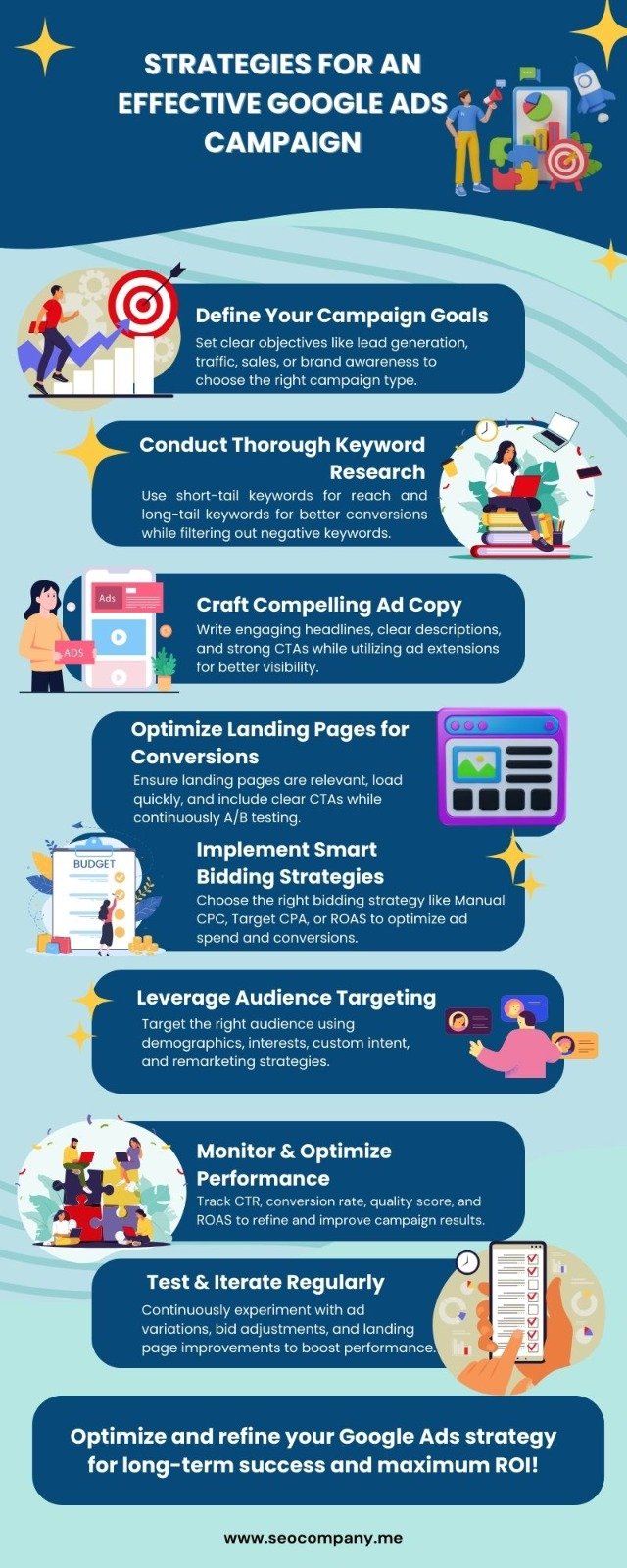Google Ads is one of the most influential digital advertising platforms, helping businesses reach their target audience effectively. However, running a successful campaign requires strategic planning and execution. If you want to maximise ROI, drive conversions, and enhance brand visibility, here are the key strategies to run an effective Google Ads campaign.
1. Define Your Campaign Goals
Before launching a Google Ads campaign, defining your objectives is crucial. Are you looking to generate leads, increase website traffic, boost sales, or raise brand awareness? Defining your goals will help you select the right campaign type (Search, Display, Video, Shopping, or Performance Max) and set the appropriate bidding strategy.
2. Conduct Thorough Keyword Research
Keywords are the foundation of any successful Google Ads campaign. Use tools like Google Keyword Planner, Ahrefs, or SEMrush to find relevant keywords with high search volume and low competition. Focus on:
Short-tail vs. Long-tail Keywords
While short-tail keywords have higher search volume, long-tail keywords often lead to better conversions due to their specificity.
Negative Keywords
Add irrelevant or low-converting keywords to your negative keyword list to prevent wasteful spending.
Competitor Analysis
Analyse your competitors’ keywords and bidding strategies to gain insights into what works best in your industry.
3. Craft Compelling Ad Copy
Your ad copy should be engaging, clear, and action-driven. A well-structured ad consists of:
Headline
Capture users’ attention with a strong, relevant headline highlighting your unique selling proposition.
Description
Provide a concise yet persuasive message that encourages users to click.
Call-to-Action (CTA)
Use actionable phrases like “Get a Free Quote,” “Shop Now,” or “Sign Up Today.”
Ad Extensions
Utilise site link, callout, structured snippet, and call extensions to provide additional information and increase click-through rates.
4. Optimise Landing Pages for Conversions
Driving traffic to your website is only half the battle; ensuring visitors take the desired action is crucial. Optimise your landing pages by:
Ensuring Relevance
The landing page content should align with your ad copy and keywords.
Improving Load Speed
A slow website can lead to high bounce rates and lost conversions.
Using Clear CTAs
Guide users towards the next step with clear and compelling calls to action.
A/B Testing
Regularly test elements like headlines, CTA buttons, and images to determine what works best.
5. Implement Smart Bidding Strategies
Google Ads offers various bidding strategies to optimise your campaign performance. Some standard options include:
Manual CPC
Gives complete control over bid amounts.
Enhanced CPC (ECPC)
Adjusts manual bids to increase conversions.
Maximise Clicks
Automatically sets bids to get the most clicks within your budget.
Target CPA (Cost-Per-Acquisition)
Focuses on getting conversions at a set cost per acquisition.
Target ROAS (Return on Ad Spend)
Optimises bids to achieve a specific return on ad spend.
Choose the bidding strategy that best aligns with your campaign goals.
Leverage Audience Targeting
Reaching the right audience is key to running a successful campaign. Google Ads provides multiple targeting options:
Demographics
Target users based on age, gender, income, and more.
Interests & Affinities
Show ads to users based on their interests and browsing behaviour.
Custom Intent Audiences
Reach people who are actively searching for your products or services.
Remarketing
Re-engage past website visitors and encourage them to complete a conversion.
Monitor and Optimise Campaign Performance
Running an effective Google Ads campaign requires continuous monitoring and optimisation. Key metrics to track include:
Click-through Rate (CTR)
Measures how often users click on your ad after seeing it.
Conversion Rate
Tracks the percentage of users who complete a desired action.
Quality Score
Google’s rating of your ad relevance, landing page experience, and expected CTR.
Return on Ad Spend (ROAS)
Evaluates the profitability of your campaign.
Use Google Ads reports and analytics to identify areas for improvement and make data-driven decisions.
8. Test and Iterate Regularly
Continuous testing and refinement are essential for long-term success. Experiment with:
Ad Variations
Test different headlines, descriptions, and CTAs to find the best-performing version.
Bid Adjustments
Increase or decrease bids based on device, location, time of day, and audience performance.
Landing Page Optimisation
Regularly update and A/B test landing pages to improve conversion rates.
Final Thoughts
Running a successful Google Ads campaign requires strategic planning, continuous monitoring, and ongoing optimisation. Setting clear goals, targeting the right audience, crafting compelling ads, and refining your approach based on data can maximise your ROI and drive meaningful business results. If you need expert assistance in managing your Google Ads campaigns, SEOCompany.me is here to help you achieve outstanding results. Contact us today for a tailored strategy!
Author
-
Manoj Negi is a digital marketing expert with over 14 years of experience in SEO, Google Ads, and performance-driven marketing. He has worked with brands like the University of Liverpool, MDIS, Mavis Tutorial Centre and Amity Global Institute, driving significant online growth. With 8+ years in the education sector, Manoj has delivered a 300% increase in leads, generated over 200,000 quality prospects, and managed a $5 million ad budget across Google Search, Display, and YouTube Ads. His data-driven strategies focus on maximizing ROI and business growth.
View all posts
 Manoj Negi
Manoj Negi




